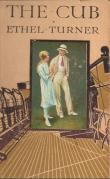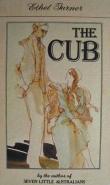AustLit
 6133736620677721697.jpg
6133736620677721697.jpg
Latest Issues
AbstractHistoryArchive Description
'Miss Ethel Turner has written a war-time story of very considerable merit and has chosen as was to be expected to develop the greater portion of the action in Australia, but the story is none the less a war-time story on that account. The tale is happily conceived and delightfully told, and there is not an uninteresting page in the book. It opens in Brussels, at the beginning of the war, when a young English girl, after some thrilling adventures, rescues a little Belgian girl—Josette—from a cruel fate. The Eng- lish girl, Brigid Lindsay, makes the ac- quaintance of the Calthrops, a wealthy Australian family, the younger son of which is the Cub of the title. The scene and the actors shift to Australia, and we are given a number of pictures of Australian patriotic activities in war time. Much againist his mother's wish, the elder of the Calthrop boys volunteers for active service, and falls in action, and the last chapter closes with the departure of the Cub to fill his fallen brother's place. The whole interest centres round the Cub, who is a youth of unusual mental equipment, and possesses ideas of his own on some pressing social and eco- nomnic problems, which are not of conven- tional type. He is in consequence regarded by his friends as "queer." Brigid is a fitting foil to the Cub and is in some respects quite as unconventional.'
Source:
'Literature: A War-time Story', The West Australian, 16 December 1915, p.5. (Via Trove Australia)
Notes
-
Epigraph: 'Few people have courage to appear as good as they really are.' -- J.C. Hare
-
'Now in thy splendour go before us, / Spirit of England, ardent eyed!...' -- Laurence Binyon.
Publication Details of Only Known VersionEarliest 2 Known Versions of
Works about this Work
-
y
 From Colonial to Modern: Transnational Girlhood in Canadian, Australian, and New Zealand Children's Literature, 1840-1940
Toronto
:
University of Toronto Press
,
2018
15039944
2018
multi chapter work
criticism
From Colonial to Modern: Transnational Girlhood in Canadian, Australian, and New Zealand Children's Literature, 1840-1940
Toronto
:
University of Toronto Press
,
2018
15039944
2018
multi chapter work
criticism
'Through a comparison of Canadian, Australian, and New Zealand texts published between 1840 and 1940, From Colonial to Modern develops a new history of colonial girlhoods revealing how girlhood in each of these emerging nations reflects a unique political, social, and cultural context.
'Print culture was central to the definition, and redefinition, of colonial girlhood during this period of rapid change. Models of girlhood are shared between settler colonies and contain many similar attitudes towards family, the natural world, education, employment, modernity, and race, yet, as the authors argue, these texts also reveal different attitudes that emerged out of distinct colonial experiences. Unlike the imperial model representing the British ideal, the transnational girl is an adaptation of British imperial femininity and holds, for example, a unique perception of Indigenous culture and imperialism. Drawing on fiction, girls’ magazines, and school magazine, the authors shine a light on neglected corners of the literary histories of these three nations and strengthen our knowledge of femininity in white settler colonies.' (Publication summary)
-
Australian and Wartime Chorography : Showing and Telling the Story of Home
2015
single work
criticism
— Appears in: Children’s Literature and Culture of the First World War 2015; (p. 139-161)'This chapter explores some of the ways in which the literary arts of poetry and novels, especially those for children and young people, and the visual arts of paintings and posters, often depicting children, were used in Australia during the First World War to show and tell not only the idea of war to those at home, but the idea of home for those at war. It is part of wartime rhetoric to set personal identity and home place as core (as something worth fighting for), but simultaneously to indent that core with qualities and places beyond the personal and the personally experienced: thus not just my home, my
family, my community, but our family, our community, our nation. This concept of home becomes imbued with symbols that both represent and unite and that establish a semiotics of home that includes both abstractions – a deep inner sense of shared cause alongside like-minded companions, and the materiality of physical space. This physical space expands into the metaphysical, into not just images of home and place and landscape, but potent metonymous and synechdocal imageries of home and place and landscapes.'Source: introduction.
-
y
 Ethel Turner and the 'Voices of Dissent' : Masculinities and Fatherhood in The Cub and Captain Cub
St Lucia
:
AustLit: The Australian Literature Resource
,
2009
Z1040837
2003
single work
criticism
Ethel Turner and the 'Voices of Dissent' : Masculinities and Fatherhood in The Cub and Captain Cub
St Lucia
:
AustLit: The Australian Literature Resource
,
2009
Z1040837
2003
single work
criticism
-
y
 Housekeeping: From the House of Misrule to The House That Was Eureka
St Lucia
:
AustLit: The Australian Literature Resource
,
2009
Z62001
1997
single work
criticism
Housekeeping: From the House of Misrule to The House That Was Eureka
St Lucia
:
AustLit: The Australian Literature Resource
,
2009
Z62001
1997
single work
criticism
-
'Preserving the White Race' : Some Australian Women's Literary Responses to the Great War
1985
single work
criticism
— Appears in: Australian Literary Studies , October vol. 12 no. 2 1985; (p. 223-233) Surveys poetry and verse, personal narratives and popular novels written by Australian women about the Great War. Finds as major preoccupations and concerns in this type of literature: fear of threats to their class and race caused by war; fear for the family; glorification of White Australia; concerns about the future of the British Empire.
-
Untitled
1915
single work
review
— Appears in: The Bulletin , 11 November vol. 36 no. 1865 1915; (p. 2)
— Review of The Cub : Six Months in His Life : A Story in War-Time 1915 single work novel -
An Australian Boy
1915
single work
review
— Appears in: The Australian Town and Country Journal , 10 November vol. 89 no. 2388 1915; (p. 44)
— Review of The Cub : Six Months in His Life : A Story in War-Time 1915 single work novel -
Literary Gossip
1916
single work
review
— Appears in: The Leader , 1 January 1916; (p. 26)
— Review of The Cub : Six Months in His Life : A Story in War-Time 1915 single work novel -
Untitled
1915
single work
review
— Appears in: The Argus , 22 October 1915; (p. 5)
— Review of The Cub : Six Months in His Life : A Story in War-Time 1915 single work novel ; From Billabong to London 1915 single work children's fiction -
y
 Ethel Turner and the 'Voices of Dissent' : Masculinities and Fatherhood in The Cub and Captain Cub
St Lucia
:
AustLit: The Australian Literature Resource
,
2009
Z1040837
2003
single work
criticism
Ethel Turner and the 'Voices of Dissent' : Masculinities and Fatherhood in The Cub and Captain Cub
St Lucia
:
AustLit: The Australian Literature Resource
,
2009
Z1040837
2003
single work
criticism
-
y
 Housekeeping: From the House of Misrule to The House That Was Eureka
St Lucia
:
AustLit: The Australian Literature Resource
,
2009
Z62001
1997
single work
criticism
Housekeeping: From the House of Misrule to The House That Was Eureka
St Lucia
:
AustLit: The Australian Literature Resource
,
2009
Z62001
1997
single work
criticism
-
'Preserving the White Race' : Some Australian Women's Literary Responses to the Great War
1985
single work
criticism
— Appears in: Australian Literary Studies , October vol. 12 no. 2 1985; (p. 223-233) Surveys poetry and verse, personal narratives and popular novels written by Australian women about the Great War. Finds as major preoccupations and concerns in this type of literature: fear of threats to their class and race caused by war; fear for the family; glorification of White Australia; concerns about the future of the British Empire. -
y
 From Colonial to Modern: Transnational Girlhood in Canadian, Australian, and New Zealand Children's Literature, 1840-1940
Toronto
:
University of Toronto Press
,
2018
15039944
2018
multi chapter work
criticism
From Colonial to Modern: Transnational Girlhood in Canadian, Australian, and New Zealand Children's Literature, 1840-1940
Toronto
:
University of Toronto Press
,
2018
15039944
2018
multi chapter work
criticism
'Through a comparison of Canadian, Australian, and New Zealand texts published between 1840 and 1940, From Colonial to Modern develops a new history of colonial girlhoods revealing how girlhood in each of these emerging nations reflects a unique political, social, and cultural context.
'Print culture was central to the definition, and redefinition, of colonial girlhood during this period of rapid change. Models of girlhood are shared between settler colonies and contain many similar attitudes towards family, the natural world, education, employment, modernity, and race, yet, as the authors argue, these texts also reveal different attitudes that emerged out of distinct colonial experiences. Unlike the imperial model representing the British ideal, the transnational girl is an adaptation of British imperial femininity and holds, for example, a unique perception of Indigenous culture and imperialism. Drawing on fiction, girls’ magazines, and school magazine, the authors shine a light on neglected corners of the literary histories of these three nations and strengthen our knowledge of femininity in white settler colonies.' (Publication summary)
-
Australian and Wartime Chorography : Showing and Telling the Story of Home
2015
single work
criticism
— Appears in: Children’s Literature and Culture of the First World War 2015; (p. 139-161)'This chapter explores some of the ways in which the literary arts of poetry and novels, especially those for children and young people, and the visual arts of paintings and posters, often depicting children, were used in Australia during the First World War to show and tell not only the idea of war to those at home, but the idea of home for those at war. It is part of wartime rhetoric to set personal identity and home place as core (as something worth fighting for), but simultaneously to indent that core with qualities and places beyond the personal and the personally experienced: thus not just my home, my
family, my community, but our family, our community, our nation. This concept of home becomes imbued with symbols that both represent and unite and that establish a semiotics of home that includes both abstractions – a deep inner sense of shared cause alongside like-minded companions, and the materiality of physical space. This physical space expands into the metaphysical, into not just images of home and place and landscape, but potent metonymous and synechdocal imageries of home and place and landscapes.'Source: introduction.
- Sydney Northeastern Suburbs, Sydney, New South Wales,
- Belgium, Western Europe, Europe,




